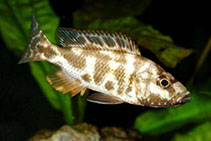| Family: |
Cichlidae (Cichlids), subfamily: Pseudocrenilabrinae |
| Max. size: |
25 cm TL (male/unsexed); 20 cm TL (female) |
| Environment: |
demersal; freshwater; pH range: 8 - 8; dH range: 9 - 19; depth range 0 - 114 m, non-migratory |
| Distribution: |
Africa: widespread occurrence in Lake Malawi, upper Shire River and Lake Malombe. |
| Diagnosis: |
Dorsal spines (total): 15-16; Dorsal soft rays (total): 10-11; Anal spines: 3-3; Anal soft rays: 9-10. Diagnosis: unique color pattern with 4 conspicuous dark bars radiating from the eye; body silvery, yellowish or blue with a highly contrasting black blotched pattern with anastomosing horizontal and vertical components; faint spots on the pectoral fins; no speckles on head and body; head length 34.0-37.0% of standard length; body depth 32.9-38.3% of standard length; dorsal fin base 49.6-53.7% of standard length; lower jaw 37.5-46.2% head length; head width 40.8-47.0% head length (Ref. 55922).
Description: outer and inner teeth in jaw unicuspid in adults, with large gap between inner and outer rows in upper jaw; outer teeth bicuspid and inner teeth weakly tricuspid in small specimens; 3-4 series of cheek scales; lower pharyngeal jaw broad and shallow, but with a relatively deep anterior blade; pharyngeal teeth widely set, sharp and stout, but not enlarged; gill-rakers stout, not elongated, the largest ones flattened; 20-24 scales in upper part of lateral line, 10-15 in lower; 5-6 scales between the pectoral and pelvic fins (Ref. 55922).
Coloration: Live: blotched pattern similar as in preserved specimens (Ref. 55922). Adult territorial males: general color blue; dorsal and anal fin blue-grey; dorsal fin with orange lappets and white submarginal band; brown maculae and striae pattern not well developed; anal fin yellow-orange distally; pectoral fins transparent with grey hue; pelvic fins dark with white leading edge (Ref. 55922). Females: white or yellow with dark blotches; unpaired fins yellow; dorsal fin lappets red-brown; pectoral and pelvic fins transparent with yellow hue; anal fin yellow distally (Ref. 55922). Color pattern of immature and non-territorial males intermediate between female and territorial male pattern, becoming more intense blue on the body with increasing territoriality (Ref. 55922). Preserved: no speckles; 4 stripes on the head radiating from the eye; there are 4 blotches on the dorsal part of the body, 4 midlateral blotches, and 3 less obvious blotches in the ventral region; general body color yellow to dark brown; dorsal part of both head and operculum, and the branchiostegal membranes, usually dark; dorsal and caudal fins with maculae; anal and pelvic fins dark; pectoral fins with spots; dorsal fin in large males with light-colored lappets, as is the trailing edge of the pelvic fins and the ventral edge of the anal fin (Ref. 55922). |
| Biology: |
Occurs in all kinds of habitats but is more common in vegetated areas of sheltered bays (Ref. 5595). Prefers soft, muddy bottoms but is also seen in purely rocky environments (Ref. 5595, 55922). Feeds on fish (Ref. 5595). Has been observed to mimic as dead and then feed on small fish that get close (Ref. 3817, 13371, 55922). Is usually solitary and territorial (Ref. 3817). |
| IUCN Red List Status: |
Least Concern (LC); Date assessed: 20 June 2018 Ref. (130435)
|
| Threat to humans: |
harmless |
Source and more info: www.fishbase.org. For personal, classroom, and other internal use only. Not for publication.

